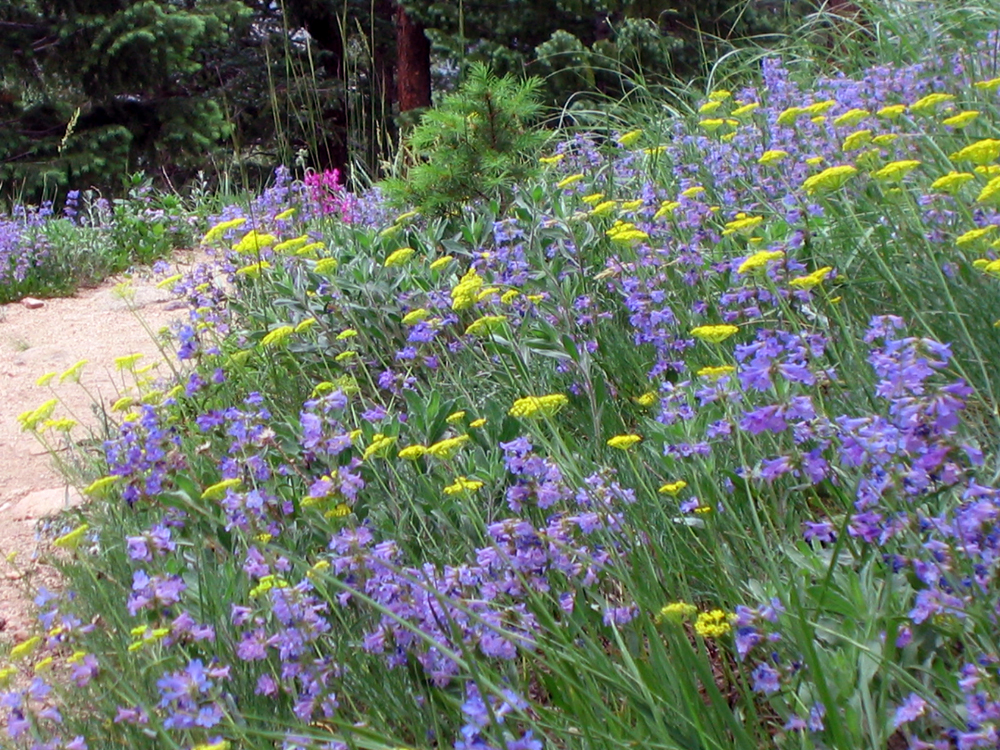This is Pollinator Week, and though we owe a huge debt to other pollinators like butterflies, moths, bats, and wasps, today is devoted to bees.

I took a time-out with bees one morning recently, hauling my laptop to Realization Point at the top of Flagstaff and sitting on the ground with my back against a ponderosa for a few hours. I thought I had gone up the mountain for the wildflower show, and indeed the carpet of blue mist penstemon (Penstemon virens) was stunning. I have this to say about four feet of snow in April: it makes for splendid wildflowers in June!

But the piece I’d forgotten about was the sound. A hum of bees across the flowered hillside, steady, low, and pulsing like a wafting veil of sound.

Bees pollinate a third of our crops. They keep the flowers blooming. They’re the matchmakers for flowers, bringing together the pollen of one flower to the ovule of the other so that seeds can grow. But this is matchmaking with a special intensity; the bee approaches each flower with the absorption of a lover. After six summery weeks of visiting flowers, she will wear herself out and die.
This is the natural lifespan of the worker bee. What is unnatural is the bee die-off that happening around the country and the world. We have already lost a huge proportion of bee populations, and the class of pesticides called neonicotinoids is being increasingly implicated (by scientific studies) in the bee die-off. Just last month Europe banned neonicotinoid use, a move that the EPA is refusing to make.
A guest column in the Boulder Daily Camera this week by Dan Bench, a local beekeeper, calls attention to the pesticides dumped on Boulder lawns. (Pesticides? In Boulder? Yes, truckloads of them.)
What can you do? he asks:
Minimize pesticide use and know what chemicals you are using. The active ingredients in any pesticide are listed on the label. The neonic active ingredients you should be concerned about are imidacloprid, clothianidin, thiomethoxam and dinotefuran. If you choose not to purchase insecticides containing these active ingredients, inform the seller of your refusal and suggest they disclose the consequences of use to their customers. You may wish to avoid any tree company that advertises or uses insecticides containing neonics.
That means most of the tree companies in Boulder, and all of those operating in my neighborhood.
He explains why these pesticides “are such ecologically insidious and effective killers”:
Even something as seemingly harmless as a treated seed is lethal. As treated seeds develop, systemic chemicals spread throughout the plant tissues—including flowers, nectar, and pollen. Plant-exuded water drops from which insects drink, as well nectar and pollen, spell death to visiting insects.
The pesticides harm the land and water not just now but also for many years down the road:
Applied to turf grass, these active ingredients can remain in the soil for years. These chemicals are water soluble; they travel with the ground water, and can enter any plant they contact.
As Dan points out, it is not just bees that are in danger and are declining fast. Birds, frogs, bats, earthworms, and soil microbes “are damaged or killed in and around areas where neonics have been applied.” Dan finishes:
More than a half-century ago, Rachel Carson in her seminal book Silent Spring warned that pesticides were decimating bird populations, silencing the twitter of avian life. We are on the brink of another even more devastating silent spring in which the buzz of the bee is hushed along with the birdsong.
Minimize your pesticide use. Cut it out entirely if you can. Definitely don’t use neonics. And be willing to talk to your neighbors about why pesticides are so dangerous.
Help keep that veil of sound humming over the field of wildflowers. Help keep food coming to your neighborhood, and to your children’s neighborhoods too. The decisions we make right here, right now, will affect their lives for years to come.
Priscilla, check out this website for the CU Museum’s citizen science project to track nesting native bees. We have one of their bee blocks up at the Ranger Cottage garden, and the little tunnels are filling up rapidly with nesting mason bees and aphid wasps. I’ll show it to you sometime when we’re up there. We even had a lovely green Chrysidid jewel wasp – a nest parasite of other bees, like a apian cowbird – checking out the bee block.
I’m glad to hear we’re getting residents in the bee box! Most readers probably aren’t aware that the native bees tend to be solitary, nesting by themselves rather than in hives. I didn’t know it until this great project started by CU. Everybody, do check out the link in the next comment!
Hey, check out this web site
http://beesneeds.colorado.edu/
It’s a citizen science project about nesting native bees.
We have a bee nesting box as part of CU program to track these bees. My husband was delighted to see that we have two takers and is faithfully reporting to the CU Museum’s project.
Cool! I want one of those too. Have fun watching the bees.